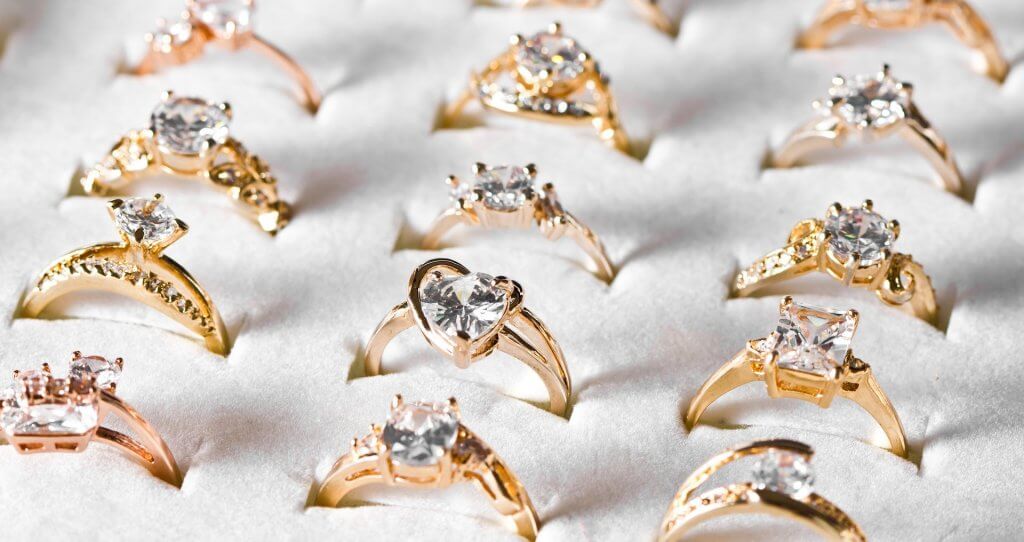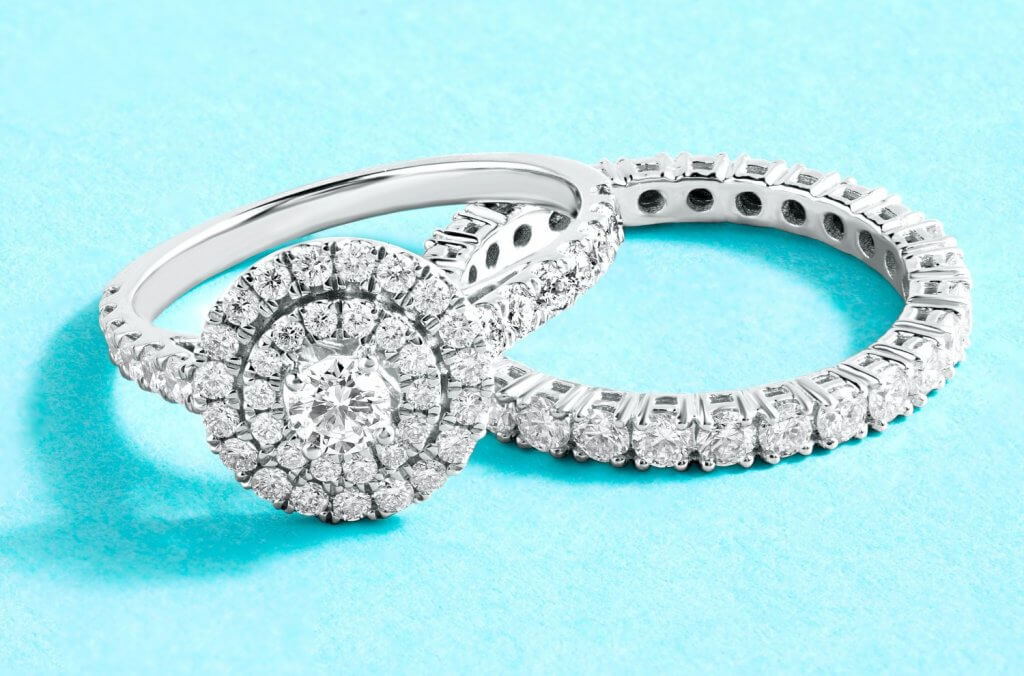Shine a light on Diamond Scams: Protect yourself
Key Takeaways
- When looking for the perfect diamond, it is important to understand how to avoid being scammed.
- The two most common diamond simulants are cubic zirconia and moissanite.
- Scammers will attempt to convince inexperienced diamond shoppers that these simulant rings are, in fact, diamond rings.
- They will also try to sell fake diamond reports. The only labs we would recommend are the GIA or the AGS, and their reports can be easily verified for authenticity.
- Laser drilling is also something to avoid, as although it will be claimed to enhance the diamond, it will only leave the diamond vulnerable to dirt and grime.
- Diamond swapping is also something to watch out for. Do not entrust your jewelry to just anyone. This is another good reason to find a trusted jeweler and build a strong relationship.

Most first-time diamond buyers are at least a little apprehensive about entering into the industry for the first time. It doesn’t take insider knowledge to be keenly aware of the fact that diamonds, being incredibly high in value, represent a pretty attractive target to scammers.
These scammers look to take advantage of the lack of understanding many first-time buyers suffer from. While diamond is one of the most distinctive, unique, and irreplaceable natural substances out there, people who have no prior experience seeing, holding, or experiencing these stones can be all too easily tricked into investing into a fake or ‘simulant’ with very little inherent value.
While understanding how to find a beautiful diamond at a good price is essential for any shopper, it’s just as important to understand how to avoid the common diamond scams that are out there – and why you do not want to wind up with a fake.
Diamond scams tend to fall into one of two categories. Either someone is trying to sell you a diamond simulant for the price of a real diamond, or someone is trying to sell you a real diamond that is worth far less than they would have you believe.
Here’s what you need to know.
Diamond Simulants
The two most common diamond simulants are cubic zirconia (CZ) and moissanite. The look of a diamond can also be imitated by white sapphire or rhinestones, but CZ and moissanite are arguably the most common.
In any case, the resemblance diamond simulants have to real diamond is undeniable, but also far from watertight. Someone who has never seen a diamond in the flesh before might be fooled, but we’re confident that even a novice diamond enthusiast would be able to sort the authentic diamonds from the simulants in a couple minutes flat.
While there’s nothing wrong with CZ jewelry, these man-made gemstones are a terrible choice for engagement rings. Weaker, duller, more porous, and far less durable, we can’t imagine anyone electing to invest in CZ for any piece of fine jewelry.
The same goes for moissanite, which features a sparkle far less desirable than the light performance created by a well cut diamond.
That’s why it’s very rare for you to encounter CZ or moissanite in fine jewelers. Some of the larger chains stock these gemstones, but not in their bridal collections.
Where’s the scam?
Scammers have realized some good potential in attempting to convince inexperienced shoppers that their CZ or moissanite rings are, in fact, diamond rings. Consider the fact that a 1 carat cubic zirconia ring could cost around $20 to produce – then compare that with the thousands of dollars shoppers are ready to invest into a 1 carat diamond engagement ring.
There are many ways to identify a diamond simulant, but this is far more easily done in person. The internet – and, more specifically, the sudden rise of ‘online jewelers’ – mean that many shoppers don’t realize the risks of making an investment like this, sight unseen.
While we’re not fans of the large online vendors, there is no risk of a shopper unwittingly purchasing a diamond simulant from them. The real trouble lies in the digital ‘marketplaces’ filled with third-party sellers.
This is, of course, yet another compelling argument in favor of shoppers taking the time to find a reputable jeweler in the local area, and only purchasing a piece that they have seen and experienced for themselves.
Fake Diamond Reports
One of the cardinal rules of investing into a diamond is that you never, ever hand over any money unless the diamond in question is accompanied by a valid diamond report. The GIA or AGS are the only labs we recommend, since they are the only labs consistent enough to offer a strong assurance over the diamond’s true value and quality, and this is pretty standard across large swathes of the industry.
The fact that this is common knowledge means that, for some scammers, forging GIA reports represents a potentially lucrative opportunity. The level of trust this lab inspires in shoppers makes that extra investment of time worthwhile, since most shoppers now know to steer clear of ungraded/uncertified diamonds.
Where’s the scam?
While the past saw plenty of diamond scams that centered on sellers trying to convince buyers that they don’t need a certificate at all, it’s more common nowadays for scammers to take the time to create them.
Anyone can think up a lab name, design a report, and start arbitrarily ‘grading’ diamonds. We’ve seen diamonds listed on some online marketplaces as being accompanied by a ‘certificate of authenticity’, which means absolutely nothing, and likely means that the seller just whipped something up on their computer and targeted the most popular grades for Cut, Clarity, and Color.
Alternatively, anyone with a little skill on the computer can create a document that loosely resembles those offered by notable labs. It would be easy enough for an experienced buyer, jeweler, or gemologist to spot the differences, but not for someone with no prior experience, just browsing on their computer. The potential benefits for the scammer are incredibly high, since they can hide behind the reliability of the name while charging thousands of dollars more than the true value of the diamond (or even diamond simulant) that they are selling.
Fortunately, all GIA reports are allocated a unique GIA Report Number, which is logged into their database. Even the most accomplished scammer can’t infiltrate that database, so it’s always best to err on the side of caution and use our GIA Diamond Report Look-Up to ensure the report you’re looking at is genuine.
Then again, provided you’re shopping from a reputable jeweler, you don’t need to get caught-up in worries over forged documents.
Undisclosed Enhancements
Diamond enhancements are artificial processes intended to improve the clarity or color of a diamond, with a view to giving it a higher market value. For many reasons, most shoppers want to avoid clarity and color enhanced diamonds – not least of all because many of these so-called ‘enhancements’ can leave the diamonds with a new set of issues.
For instance, laser drilling can be used to get rid of unsightly incisions within a diamond. The trouble is, that laser drill hole is permanent, and makes the diamond vulnerable to gathering dirt and grime and, over time, looking even worse than it did before. We consider laser drill holes to be one of the diamond inclusions any shopper should avoid.
People who want to invest in natural diamonds – who value the long, wild history behind these stones and want to celebrate their natural beauty – are not interested in the minor savings associated with clarity and color enhanced diamonds.
Where’s the scam?
As a shopper, it’s up to you to do your research into enhanced diamonds and to understand why you probably don’t want to waste your money on one. This is, of course, easy enough if the diamond you were considering is clearly labelled as ‘clarity enhanced’ – something we came across quite frequently in our review of Macy’s diamonds – but what about when sellers don’t disclose this information?
This is yet another reason why you should be very cautious about trusting any seller you’re not totally confident in. The only establishments you should trust are those that boast a strong reputation in the local community – and in the wider industry – as a result of years of strong, high quality work for their clients.
Swapping Diamonds
We’ve all heard the horror stories. A friend of a friend (of a friend) took her ring in for a routine clean and tune-up and, after getting it back, realized that her diamond had been switched out for an inferior, cheaper alternative. It’s enough to give anyone nightmares, although it’s certainly not a common occurrence.
It is, however, a great deterrent against entrusting your precious jewelry to just anyone – and, of course, another compelling argument in favor of building a long-standing relationship with a local jeweler, who has no interest at all in swapping diamonds.
Where’s the scam?
The idea is that the jewelers who switch-out diamonds are then able to re-sell that diamond to a new customer – a customer who will, six months down the line, come back into that same store for a clean and tune-up – and so the cycle continues.
There are plenty of stories, anecdotes, and urban legends out there – and it’s an effective cautionary tale against opening the phonebook to a random page and just picking any jeweler that pops up – but it’s not something you need to worry yourself over if you’ve tracked down a reputable jeweler to work with.
Why? Because it’s simply not in their best interests. Established jewelers don’t need to ‘make a quick buck’ swapping out diamonds for CZ. Their work and skill are where their money is made – not in dishonesty – so there are no risks provided you find a great jeweler to work with.
Our Summary
We would never deny that it’s daunting for a first-time diamond buyer to consider the many different traps that have been laid down for them. Unscrupulous sellers looking to take advantage of people who are a little green about the process of finding a diamond – or hellbent on getting the lowest price possible – will always be there, lying in wait for someone to fall for their scheme.
These scams have only grown more common with the rising significance of internet shopping. It only takes a small investment of time for a scammer to create a professional-looking website and, after that, all they have to do is wait for a shopper to click through.
Provided that you do your own due diligence – research the specifics of diamond value, quality, and certification – and track down a reputable, local jeweler who has maintained a strong, physical presence within the local community, you don’t need to get too caught-up in worries over diamond scams. These ploys are intended to target shoppers who know nothing about diamonds – who are not confident in distinguishing between CZ and diamond, or between a report from the GIA and a ‘certificate of authenticity’ put together by the seller.

Mar 17, 2022 By Willyou.net
Engagement Ring Statistics You Should Know

Mar 26, 2022 By Willyou.net
Understanding the Differences: Anniversary Band vs Wedding Band








